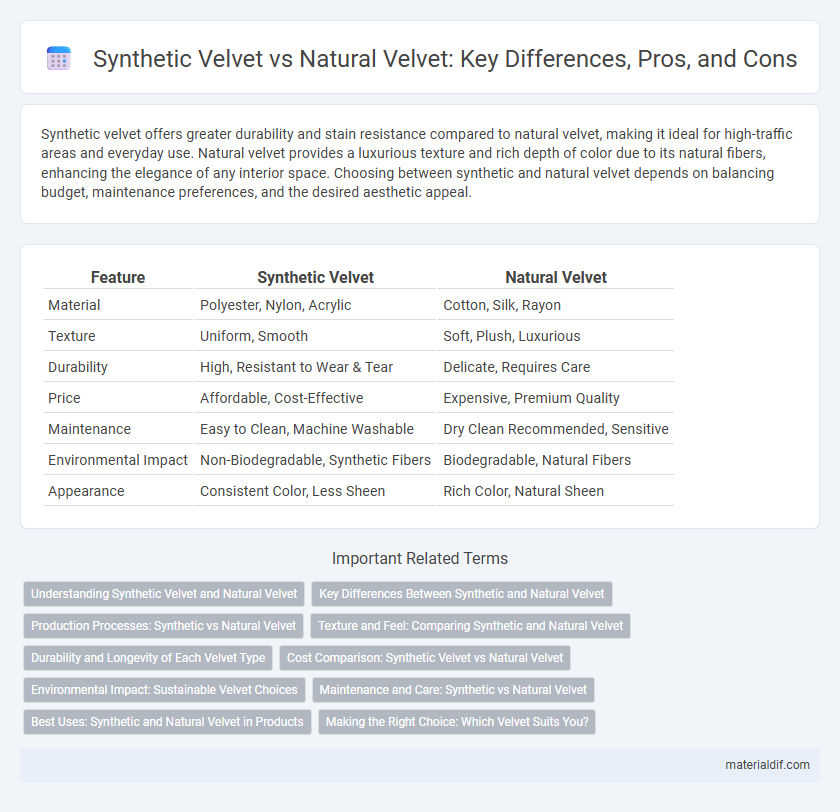Synthetic velvet offers greater durability and stain resistance compared to natural velvet, making it ideal for high-traffic areas and everyday use. Natural velvet provides a luxurious texture and rich depth of color due to its natural fibers, enhancing the elegance of any interior space. Choosing between synthetic and natural velvet depends on balancing budget, maintenance preferences, and the desired aesthetic appeal.
Table of Comparison
| Feature | Synthetic Velvet | Natural Velvet |
|---|---|---|
| Material | Polyester, Nylon, Acrylic | Cotton, Silk, Rayon |
| Texture | Uniform, Smooth | Soft, Plush, Luxurious |
| Durability | High, Resistant to Wear & Tear | Delicate, Requires Care |
| Price | Affordable, Cost-Effective | Expensive, Premium Quality |
| Maintenance | Easy to Clean, Machine Washable | Dry Clean Recommended, Sensitive |
| Environmental Impact | Non-Biodegradable, Synthetic Fibers | Biodegradable, Natural Fibers |
| Appearance | Consistent Color, Less Sheen | Rich Color, Natural Sheen |
Understanding Synthetic Velvet and Natural Velvet
Synthetic velvet, typically made from polyester or nylon fibers, offers enhanced durability, resistance to stains, and affordability compared to natural velvet. Natural velvet, derived from silk, cotton, or rayon, provides a softer texture, richer sheen, and greater breathability, making it highly prized for luxury upholstery and fashion. Understanding the fiber composition and care requirements is essential for selecting between synthetic velvet's practicality and natural velvet's authentic elegance.
Key Differences Between Synthetic and Natural Velvet
Synthetic velvet, typically made from polyester or nylon, offers greater durability, stain resistance, and affordability compared to natural velvet, which is derived from silk or cotton fibers and prized for its softness and luxurious texture. Natural velvet exhibits superior breathability and a richer, deeper luster that ages gracefully, while synthetic velvet is easier to maintain and less susceptible to fading or shrinking. The key differences lie in fiber origin, maintenance requirements, comfort levels, and price points, making natural velvet ideal for high-end upholstery and apparel and synthetic velvet suitable for everyday use and budget-conscious projects.
Production Processes: Synthetic vs Natural Velvet
Synthetic velvet is produced using man-made fibers such as polyester or nylon, which are created through chemical processes involving polymerization and extrusion, allowing for consistent texture and color control. Natural velvet, derived from silk or cotton, requires labor-intensive cultivation, harvesting, and hand-weaving procedures that emphasize artisanal craftsmanship and result in unique fiber variations. The manufacturing of synthetic velvet is faster and more cost-effective, whereas natural velvet entails longer production times and higher costs due to the complexity of its natural materials and traditional techniques.
Texture and Feel: Comparing Synthetic and Natural Velvet
Synthetic velvet features a smooth, uniform texture with a slightly plastic feel, offering durability and ease of maintenance. Natural velvet, made from silk or cotton, provides a richer, softer touch with a more complex pile that changes with light and angle. The tactile warmth and luxurious softness of natural velvet create an opulent sensory experience unmatched by synthetic alternatives.
Durability and Longevity of Each Velvet Type
Synthetic velvet, often made from polyester or nylon, exhibits superior durability due to its resistance to wear, fading, and moisture compared to natural velvet, which is typically made from silk or cotton fibers. Natural velvet, while luxurious and soft, tends to be more delicate and prone to damage from friction and sunlight exposure, resulting in a shorter lifespan. Choosing synthetic velvet ensures longer-lasting fabric performance in high-traffic or frequently used applications, making it ideal for upholstery and heavy-duty use.
Cost Comparison: Synthetic Velvet vs Natural Velvet
Synthetic velvet is generally more cost-effective than natural velvet, offering similar luxurious textures at a fraction of the price. Natural velvet, made from silk or cotton fibers, commands higher prices due to the labor-intensive production and premium raw materials. Choosing synthetic velvet can significantly reduce expenses in upholstery, fashion, or decor without sacrificing aesthetic appeal.
Environmental Impact: Sustainable Velvet Choices
Synthetic velvet, typically made from polyester or nylon, has a significant environmental impact due to its reliance on nonrenewable petroleum resources and the release of microplastics during washing. Natural velvet, crafted from cotton, silk, or viscose, is biodegradable but may involve intensive water and pesticide use, especially in cotton cultivation. Sustainable velvet choices prioritize organic fibers, eco-friendly dyes, and recycled materials to minimize pollution and resource consumption in velvet production.
Maintenance and Care: Synthetic vs Natural Velvet
Synthetic velvet requires less maintenance compared to natural velvet, as it is more resistant to stains and fading and can often be cleaned with mild detergents and water. Natural velvet, made from silk or cotton fibers, demands more delicate care, including dry cleaning and avoidance of direct sunlight to prevent damage and preserve its texture. Proper maintenance of synthetic velvet extends its durability in high-traffic areas, while natural velvet demands meticulous upkeep to retain its luxurious appearance over time.
Best Uses: Synthetic and Natural Velvet in Products
Synthetic velvet offers durability and stain resistance, making it ideal for upholstery, heavy-use furniture, and fashion items that require easy maintenance and longevity. Natural velvet, derived from silk or cotton, provides a luxurious texture and breathability, making it perfect for high-end garments, drapery, and decorative cushions where elegance and softness are paramount. Both materials excel in different applications, with synthetic velvet favored for practicality and natural velvet chosen for its rich, authentic feel.
Making the Right Choice: Which Velvet Suits You?
Synthetic velvet offers durability, stain resistance, and affordability, making it ideal for high-traffic areas and budget-conscious buyers. Natural velvet, typically made from silk or cotton, provides a luxurious texture and breathability, perfect for elegant, low-traffic spaces seeking a premium feel. Understanding the specific use, maintenance needs, and aesthetic preferences will help you decide whether synthetic or natural velvet suits your lifestyle best.
Synthetic Velvet vs Natural Velvet Infographic

 materialdif.com
materialdif.com